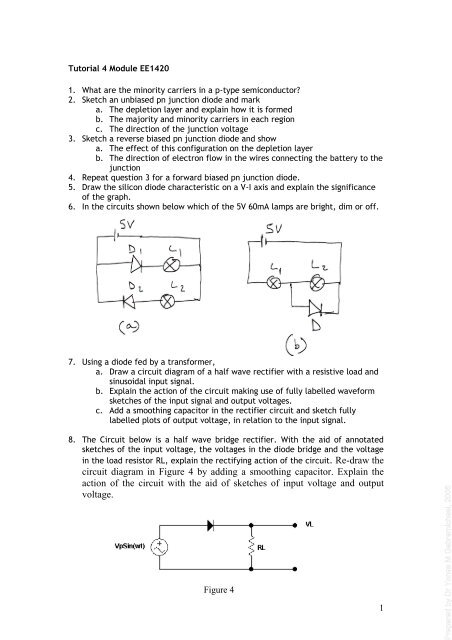Tutorial 4 - Staff.city.ac.uk
Tutorial 4 - Staff.city.ac.uk Tutorial 4 - Staff.city.ac.uk
Tutorial 4 Module EE1420 1. What are the minority carriers in a p-type semiconductor? 2. Sketch an unbiased pn junction diode and mark a. The depletion layer and explain how it is formed b. The majority and minority carriers in each region c. The direction of the junction voltage 3. Sketch a reverse biased pn junction diode and show a. The effect of this configuration on the depletion layer b. The direction of electron flow in the wires connecting the battery to the junction 4. Repeat question 3 for a forward biased pn junction diode. 5. Draw the silicon diode characteristic on a V-I axis and explain the significance of the graph. 6. In the circuits shown below which of the 5V 60mA lamps are bright, dim or off. 7. Using a diode fed by a transformer, a. Draw a circuit diagram of a half wave rectifier with a resistive load and sinusoidal input signal. b. Explain the action of the circuit making use of fully labelled waveform sketches of the input signal and output voltages. c. Add a smoothing capacitor in the rectifier circuit and sketch fully labelled plots of output voltage, in relation to the input signal. 8. The Circuit below is a half wave bridge rectifier. With the aid of annotated sketches of the input voltage, the voltages in the diode bridge and the voltage in the load resistor RL, explain the rectifying action of the circuit. Re-draw the circuit diagram in Figure 4 by adding a smoothing capacitor. Explain the action of the circuit with the aid of sketches of input voltage and output voltage. Figure 4 1 Prepared by Dr Yonas M Gebremichael, 2005
<strong>Tutorial</strong> 4 Module EE1420<br />
1. What are the minority carriers in a p-type semiconductor?<br />
2. Sketch an unbiased pn junction diode and mark<br />
a. The depletion layer and explain how it is formed<br />
b. The majority and minority carriers in e<strong>ac</strong>h region<br />
c. The direction of the junction voltage<br />
3. Sketch a reverse biased pn junction diode and show<br />
a. The effect of this configuration on the depletion layer<br />
b. The direction of electron flow in the wires connecting the battery to the<br />
junction<br />
4. Repeat question 3 for a forward biased pn junction diode.<br />
5. Draw the silicon diode char<strong>ac</strong>teristic on a V-I axis and explain the significance<br />
of the graph.<br />
6. In the circuits shown below which of the 5V 60mA lamps are bright, dim or off.<br />
7. Using a diode fed by a transformer,<br />
a. Draw a circuit diagram of a half wave rectifier with a resistive load and<br />
sinusoidal input signal.<br />
b. Explain the <strong>ac</strong>tion of the circuit making use of fully labelled waveform<br />
sketches of the input signal and output voltages.<br />
c. Add a smoothing cap<strong>ac</strong>itor in the rectifier circuit and sketch fully<br />
labelled plots of output voltage, in relation to the input signal.<br />
8. The Circuit below is a half wave bridge rectifier. With the aid of annotated<br />
sketches of the input voltage, the voltages in the diode bridge and the voltage<br />
in the load resistor RL, explain the rectifying <strong>ac</strong>tion of the circuit. Re-draw the<br />
circuit diagram in Figure 4 by adding a smoothing cap<strong>ac</strong>itor. Explain the<br />
<strong>ac</strong>tion of the circuit with the aid of sketches of input voltage and output<br />
voltage.<br />
Figure 4<br />
1<br />
Prepared by Dr Yonas M Gebremichael, 2005
9. The Circuit below is a full wave bridge rectifier. With the aid of annotated<br />
sketches of the input voltage, the voltages in the diode bridge and the voltage<br />
in the load resistor RL, explain the rectifying <strong>ac</strong>tion of the circuit.<br />
2<br />
Prepared by Dr Yonas M Gebremichael, 2005



